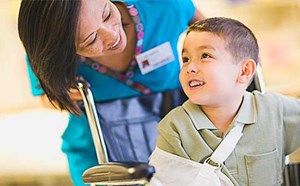
Firearm Safety Among Children and Teens (FACTS)
Among children in the United States, firearm-related fatalities are the second leading cause of death and Emergency Physicians have long been on the front line and at the front of firearm injury prevention efforts.
Such preventable injuries include the unintentional shooting of a toddler who finds a gun, the use of a firearm to self-inflict harm by a suicidal teen, the escalation of fighting or dating violence, or more recently by an adolescent as part of a tragic school shooting.
Research and training in the field of firearm injury prevention needs to be substantially increased to develop evidence-based solutions to prevent and reduce firearm injury. There is a current deficit of data-driven solutions. Reducing firearm-related deaths requires an injury prevention science. Although the problem is complex, if we apply injury prevention science the same way we have for car crash preventions and deaths over the years, we will reduce the deaths caused by gun violence.
To address this need, the National Institute of Child Health and Human Development (NICHD) recently awarded a $5 million grant to two emergency physicians at the University of Michigan, Drs. Cunningham (project PI and Former chair of ACEP trauma and Injury section) and Carter. Drs. Cunningham and Carter are partnering with public health researcher Dr. Zimmerman to lead the team of more than 20 researchers at 12 universities and health systems across the nation.
The award represents the largest NIH funding commitment in the past 20 years to reduce firearm injury. Emergency Medicine collaborators also include Dr. Ranney (Rhode Island Hospital/Brown University), Hargarten (Medical College of Wisconsin), and PEM collaborators Dr. Goyal (Children’s Hospital of Chicago/Northwestern University) and Dr. Alpern (Children's National Health System). The new consortium brings together expertise from many fields including scientists from public health, adult and pediatric emergency medicine, pediatrics, criminal justice, psychiatry, psychology, data science and trauma surgery. The five-year effort allows the collaborators, along with stakeholder partners, to form a consortium on research on the subject and fill a critical knowledge gap.
The project is called the Firearm-safety Among Children & Teens Consortium (FACTS). It is composed of stakeholder groups that are an important asset to the academic conversation and it includes gun owners and firearm safety trainers, educators and law enforcement partners, such as teachers, parent groups and hunting and sports enthusiasts. The consortium respects gun ownership as an important part of the cultural fabric of our society in this country and having a stakeholder group that has a wide variety of political views and is providing input along the way is invaluable to our joint goals of preventing firearm injury and death among children.
FACTS first task is to create a research agenda for the field of firearm injury specific to pediatrics that will be published this fall. Following this broad literature review and consensus building, the team will embark on five projects that span the spectrum of epidemiology and prevention, as well as investigation on needs and practices following youth involvement in firearm violence. The consortium will create a data archive on childhood firearm injury (available this fall), which will allow for researchers to efficiently utilize existing and future research data on firearm injuries among the age group. The consortium will also train a cadre of new researchers, including postdoctoral trainees, residents, and graduate students, as well as provide a webinar series to educate researchers on this topic of injury science. The FACTS consortium begins to address the lack of trained researchers, junior faculty, and funding for seed projects in this research area. In this way it is a capacity-building grant to jumpstart the field of pediatric firearm injury prevention. This grant signals a focus and will of NIH and leadership of NICHD to seek injury science-based solutions to the second leading cause of death among our nation’s children: firearms. Although far more funding is needed to bring research to the level needed and has proven effective for other public health crisis- this is a much-needed jumpstart.
FACTS: Building Research Capacity for Firearm Safety Among Children is project number R24HD087149 and funded by the National Institute of Child Health & Human Development. PI Cunningham/ Zimmerman
Rebecca Cunningham, MD, FACEP



